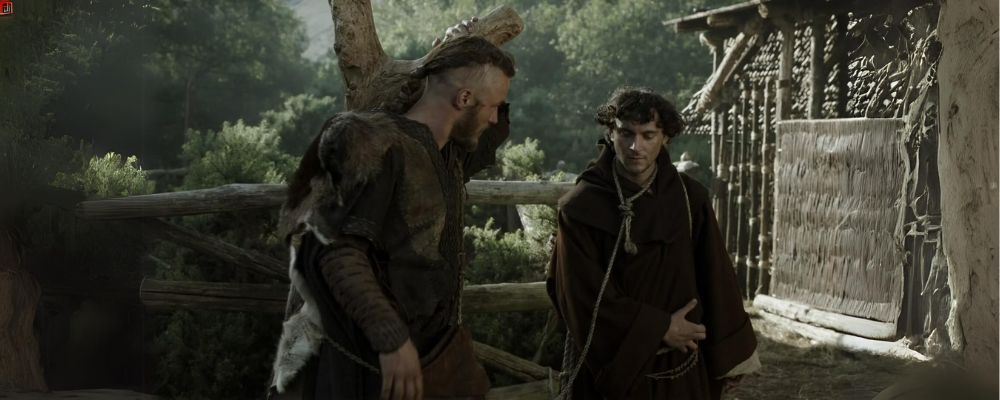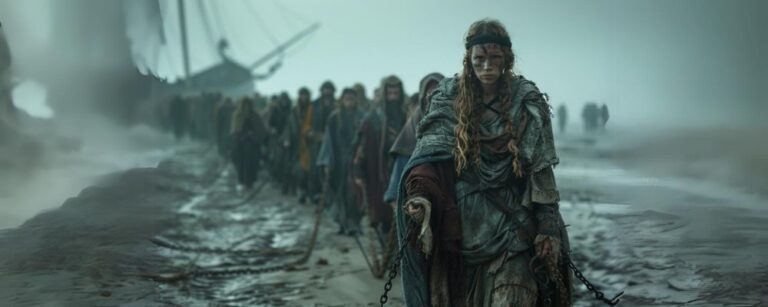We know that besides farming, the people of Denmark, Norway, and Sweden raided neighboring people as a legitimate economic prospect. It was this raiding that earned these people the name “Vikings”.
But could the Vikings really get their hands on enough trinkets of gold and silver to make it worthwhile to put together a group of warriors and a fleet of ships and feed and maintain them for several months each year ?
. No. It wasn’t the old plundered from wealthy churches and monasteries that made raiding worthwhile.
The Vikings would also claim new lands for themselves and were involved in extortion, convincing communities to pay them and not to attack.
However, perhaps the most lucrative part of raiding was slavery.
The Vikings regularly kidnapped people and took them home as slaves both to work in Scandinavia and to sell on international slave markets.
Slavery may have been one of the biggest economic activities in the Viking world.
How Were Slaves Procured and Sold ?

Slavery seems to have been common in the Viking world before they started raiding their neighbors at the end of the 8th century.
An Eddic poem called the Lay of Rig described how the social classes of the Viking world were created.
The god Heimdall, in the guise of a man called Rig, spent three nights with three different families, establishing their social status as slaves, called thralls, farmers, and rulers.
It seems that in the early Viking age, there were poor communities that were in hereditary slavery, not dissimilar from serfs.
Vikings could also become slaves. Some would willingly submit to slavery for a certain period of time to pay off debts.
A fixed period of slavery could also be a punishment for crimes such as murder or theft.
An example survives of a woman who was forced to become the slave of a person that she stole from.
These slaves would have mainly worked in Viking lands, and most Viking households would have had a couple of slaves.
But when the Vikings started raiding, as well as carrying off treasure, they would also carry off people to become slaves.
Each individual ship would have only carried a handful of slaves due to space restrictions.
Therefore, when the three Viking ships attacked Lindisfarne in 793 CE, they probably only took a dozen slaves.
But when Paris was attacked around 50 years later, the Vikings had 120 ships.
Many of these slaves were taken home to Scandinavia and sold to locals, but bigger slave trades soon developed.
We know from written sources that there were large slave markets at Hebedy, in the very south of Denmark, and at Boghar on the Volga River in the East.
Historians now believe that slaves were the main commodity traded by the Vikings in the East.
They even sold slaves to the Byzantines and would sometimes castrate slaves to make them more valuable to that market.
While there were some large slave markets, it seems that traveling Vikings would also take a few slaves with them and sell a couple at a time whenever the opportunity presented itself, and then replenish their supply.
What Was It Like to Be a Thrall ?

What was it like to be a slave in the Viking world ?
It depended greatly on your conditions, but generally speaking, slaves were people without personal rights. They could own nothing, make no decisions about their own lives, and had no autonomy over their bodies.
They were forced to do the worst jobs that demanded the hardest physical labor, and sexual assault was commonplace.
The description of slaves in the Lay of Rig is telling about the conditions of slaves.
According to the stories, the couple was called Thrall and Thir, the female version of Thrall.
Their male children were called Noisy, Byreboy, Stout, Sticky, Bedmate, Badbreath, Stumpy, Fatty, Sluggish, Grizzled, Stooper and Longlegs.
The daughters are dubbed Stumpina, Dumpy, Bulgingcalves, Bellowsnose, Shouty, Bondwoman, Greatgossip, Raggedyhips, and Craneshanks. All these names are clearly pejorative, and several imply ill health and a lack of hygiene.
One clearly refers to sexual servitude.
The Arab diplomat Ibn Fadlan visited a Viking community on the Volga in 922 CE and mentioned that two attractive slave girls, who were to be sold, were sexually abused by their owners while others watched.
The poem also suggests that the Thralls had to do the hardest work, carrying heavy bundles of kindling and plaiting materials for basket making, fixing fences, dunging fields, caring for the pigs, watching over the goats, and digging the peat.
Their bodies are marked by manual labor, with wrinkled skin burnt by the sun, scabbed nails, gnarled knuckles, and dull eyes. Their bare feet are covered with soil.
In the home, they were treated little better than domestic animals, and would even have slept at the far end of the longhouse with the animals, including cattle in the winter.
What Happened to Viking Slaves ?

Unless Viking citizens were condemned to a fixed period of slavery, slavery was for life.
The children of slaves were also slaves, including children that free men fathered on slave women if they refused to claim them.
However, slaves could be freed at any time by the person who owned them, and this was known to happen.
A rune inscription set up at Hirning in Jutland records a man commemorating the man who granted him his freedom.
But Slavery in general ended in the Viking world with the rise of Christianity, because the church did not approve of Christians enslaving one another.
One monk visited Hebedy in 870 CE, he was shocked to see Christians for sale as slaves. He sold all his possessions to buy the slaves and set them free.
The end of slavery was gradual after the widespread adoption of slavery across the 11th century.
Rules regarding slavery are still mentioned in the Codex Holmiensis, a Danish law code from Jutland dating to 1241.
Slavery in the Viking world doesn’t receive more attention because slaves leave few archaeological traces to reveal their lives, and there aren’t people living in Scandinavia today who are still directly affected by the consequences of slavery.







